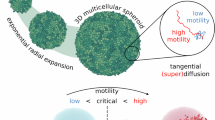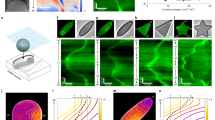Abstract
The shape of motile cells is determined by many dynamic processes spanning several orders of magnitude in space and time, from local polymerization of actin monomers at subsecond timescales to global, cell-scale geometry that may persist for hours. Understanding the mechanism of shape determination in cells has proved to be extremely challenging due to the numerous components involved and the complexity of their interactions. Here we harness the natural phenotypic variability in a large population of motile epithelial keratocytes from fish (Hypsophrys nicaraguensis) to reveal mechanisms of shape determination. We find that the cells inhabit a low-dimensional, highly correlated spectrum of possible functional states. We further show that a model of actin network treadmilling in an inextensible membrane bag can quantitatively recapitulate this spectrum and predict both cell shape and speed. Our model provides a simple biochemical and biophysical basis for the observed morphology and behaviour of motile cells.
This is a preview of subscription content, access via your institution
Access options
Subscribe to this journal
Receive 51 print issues and online access
$199.00 per year
only $3.90 per issue
Buy this article
- Purchase on SpringerLink
- Instant access to full article PDF
Prices may be subject to local taxes which are calculated during checkout




Similar content being viewed by others
References
Carlier, M. F. & Pantaloni, D. Control of actin assembly dynamics in cell motility. J. Biol. Chem. 282, 23005–23009 (2007)
Pollard, T. D., Blanchoin, L. & Mullins, R. D. Molecular mechanisms controlling actin filament dynamics in nonmuscle cells. Annu. Rev. Biophys. Biomol. Struct. 29, 545–576 (2000)
Zaidel-Bar, R., Cohen, M., Addadi, L. & Geiger, B. Hierarchical assembly of cell-matrix adhesion complexes. Biochem. Soc. Trans. 32, 416–420 (2004)
Bakal, C., Aach, J., Church, G. & Perrimon, N. Quantitative morphological signatures define local signaling networks regulating cell morphology. Science 316, 1753–1756 (2007)
Anderson, K. I. & Cross, R. Contact dynamics during keratocyte motility. Curr. Biol. 10, 253–260 (2000)
Lee, J. & Jacobson, K. The composition and dynamics of cell–substratum adhesions in locomoting fish keratocytes. J. Cell Sci. 110, 2833–2844 (1997)
Svitkina, T. M., Verkhovsky, A. B., McQuade, K. M. & Borisy, G. G. Analysis of the actin–myosin II system in fish epidermal keratocytes: mechanism of cell body translocation. J. Cell Biol. 139, 397–415 (1997)
Theriot, J. A. & Mitchison, T. J. Actin microfilament dynamics in locomoting cells. Nature 352, 126–131 (1991)
Euteneuer, U. & Schliwa, M. Persistent, directional motility of cells and cytoplasmic fragments in the absence of microtubules. Nature 310, 58–61 (1984)
Goodrich, H. B. Cell behavior in tissue cultures. Biol. Bull. 46, 252–262 (1924)
Lacayo, C. I. et al. Emergence of large-scale cell morphology and movement from local actin filament growth dynamics. PLoS Biol. 5, e233 (2007)
Lee, J., Ishihara, A., Theriot, J. A. & Jacobson, K. Principles of locomotion for simple-shaped cells. Nature 362, 167–171 (1993)
Jurado, C., Haserick, J. R. & Lee, J. Slipping or gripping? Fluorescent speckle microscopy in fish keratocytes reveals two different mechanisms for generating a retrograde flow of actin. Mol. Biol. Cell 16, 507–518 (2005)
Kucik, D. F., Elson, E. L. & Sheetz, M. P. Cell migration does not produce membrane flow. J. Cell Biol. 111, 1617–1622 (1990)
Grimm, H. P., Verkhovsky, A. B., Mogilner, A. & Meister, J. J. Analysis of actin dynamics at the leading edge of crawling cells: implications for the shape of keratocyte lamellipodia. Eur. Biophys. J. 32, 563–577 (2003)
Prass, M., Jacobson, K., Mogilner, A. & Radmacher, M. Direct measurement of the lamellipodial protrusive force in a migrating cell. J. Cell Biol. 174, 767–772 (2006)
Vallotton, P. et al. Tracking retrograde flow in keratocytes: news from the front. Mol. Biol. Cell 16, 1223–1231 (2005)
Cootes, T. F., Taylor, C. J., Cooper, D. H. & Graham, J. Active shape models — their training and application. Comput. Vis. Image Underst. 61, 38–59 (1995)
Pincus, Z. & Theriot, J. A. Comparison of quantitative methods for cell-shape analysis. J. Microsc. 227, 140–156 (2007)
Petchprayoon, C. et al. Fluorescent kabiramides: new probes to quantify actin in vitro and in vivo . Bioconjug. Chem. 16, 1382–1389 (2005)
Tanaka, J. et al. Biomolecular mimicry in the actin cytoskeleton: mechanisms underlying the cytotoxicity of kabiramide C and related macrolides. Proc. Natl Acad. Sci. USA 100, 13851–13856 (2003)
Sanger, J. W., Gwinn, J. & Sanger, J. M. Dissolution of cytoplasmic actin bundles and the induction of nuclear actin bundles by dimethyl sulfoxide. J. Exp. Zool. 213, 227–230 (1980)
Watanabe, N. & Mitchison, T. J. Single-molecule speckle analysis of actin filament turnover in lamellipodia. Science 295, 1083–1086 (2002)
Pollard, T. D. & Borisy, G. G. Cellular motility driven by assembly and disassembly of actin filaments. Cell 112, 453–465 (2003)
Wang, Y. L. Exchange of actin subunits at the leading edge of living fibroblasts: possible role of treadmilling. J. Cell Biol. 101, 597–602 (1985)
Kozlov, M. M. & Mogilner, A. Model of polarization and bistability of cell fragments. Biophys. J. 93, 3811–3819 (2007)
Sheetz, M. P., Sable, J. E. & Dobereiner, H. G. Continuous membrane–cytoskeleton adhesion requires continuous accommodation to lipid and cytoskeleton dynamics. Annu. Rev. Biophys. Biomol. Struct. 35, 417–434 (2006)
Schaus, T. E. & Borisy, G. Performance of a population of independent filaments in lamellipodial protrusion. Biophys. J. (in the press)
Footer, M. J., Kerssemakers, J. W., Theriot, J. A. & Dogterom, M. Direct measurement of force generation by actin filament polymerization using an optical trap. Proc. Natl Acad. Sci. USA 104, 2181–2186 (2007)
Kovar, D. R. & Pollard, T. D. Insertional assembly of actin filament barbed ends in association with formins produces piconewton forces. Proc. Natl Acad. Sci. USA 101, 14725–14730 (2004)
Parekh, S. H., Chaudhuri, O., Theriot, J. A. & Fletcher, D. A. Loading history determines the velocity of actin-network growth. Nature Cell Biol. 7, 1219–1223 (2005)
Mitchison, T. J. & Cramer, L. P. Actin-based cell motility and cell locomotion. Cell 84, 371–379 (1996)
Ridley, A. J. et al. Cell migration: integrating signals from front to back. Science 302, 1704–1709 (2003)
Raucher, D. & Sheetz, M. P. Cell spreading and lamellipodial extension rate is regulated by membrane tension. J. Cell Biol. 148, 127–136 (2000)
Gander, W., Golub, G. H. & Strebel, R. Least-squares fitting of circles and ellipses. BIT 34, 558–578 (1994)
Wilson, C. A. & Theriot, J. A. A correlation-based approach to calculate rotation and translation of moving cells. IEEE Trans. Image Process. 15, 1939–1951 (2006)
Acknowledgements
We thank C. Lacayo, C. Wilson and M. Kozlov for discussion, and P. Yam, C. Lacayo, E. Braun and T. Pollard for comments on the manuscript. K.K. is a Damon Runyon Postdoctoral Fellow supported by the Damon Runyon Cancer Research Foundation, and a Horev Fellow supported by the Taub Foundations. A.M. is supported by the National Science Foundation grant number DMS-0315782 and the National Institutes of Health Cell Migration Consortium grant number NIGMS U54 GM64346. J.A.T. is supported by grants from the National Institutes of Health and the American Heart Association.
Author Contributions Z.P., K.K., E.L.B., G.M.A. and J.A.T. designed the experiments. K.K., G.M.A., E.L.B. and Z.P. performed the experiments. Z.P. together with K.K., A.M., G.M.A. and E.L.B. analysed the data. A.M. together with K.K., Z.P., E.L.B., G.M.A. and J.A.T. developed the model. G.M. provided the kabiramide C probe. Z.P., K.K., A.M. and J.A.T. wrote the paper. All authors discussed the results and commented on the manuscript.
Author information
Authors and Affiliations
Corresponding author
Supplementary information
Supplementary information
This file contains Supplementary Discussion, Supplementary Methods and Supplementary Figures S1-S8 with Legends. The file includes: a table of model assumptions and their rationales; mathematical derivations of the model and equations presented in the main text; further discussion of the relation of the model to experimental data and other model predictions; discussion of the limitations of the model; analysis of the results of the molecular perturbations; a rationale for ruling out alternate models; and supplementary methods including shape-alignment algorithms. (PDF 4973 kb)
Supplementary information
The file contains Supplementary Data with multiple files containing the measurements presented in the main and supplementary text, including: live cell populations (stained with kabiramide C and unstained) imaged at 30 seconds apart; several live cells followed through time; a fixed-cell population; populations of live cells perturbed with various pharmacological agents; and time-lapse measurements of cells challenged with DMSO. (zip-compressed comma-separated value files.(zip-compressed comma-separated value files. (ZIP 169 kb)
Supplementary information
The file contains Supplementary Movie 1. This movie shows a motile keratocyte before, during and after transient treatment with DMSO. The time lapse covers a period of about 28 min (the DMSO perturbation is applied about 6 min into the movie), and the field of view is 87 ?m wide. The movie clearly illustrates how the cell recovers from an acute perturbation and resumes its original shape and speed. (MOV 242 kb)
Supplementary information
The file contains Supplementary Movie 2. This movie shows phase-contrast (left) and fluorescence (right) images of a kabiramide C stained "coherent" keratocyte. The time lapse covers a period of about 6 min, and the field of view is 56 ?m wide. (MOV 1935 kb)
Supplementary information
The file contains Supplementary Movie 3. This movie shows phase-contrast (left) and fluorescence (right) images of a kabiramide C stained "decoherent" keratocyte. The time lapse covers a period of about 11 min, and the field of view is 56 ?m wide. (MOV 2977 kb)
Rights and permissions
About this article
Cite this article
Keren, K., Pincus, Z., Allen, G. et al. Mechanism of shape determination in motile cells. Nature 453, 475–480 (2008). https://doi.org/10.1038/nature06952
Received:
Accepted:
Issue date:
DOI: https://doi.org/10.1038/nature06952
This article is cited by
-
Mechanochemical feedback loop drives persistent motion of liposomes
Nature Physics (2023)
-
On the reaction–diffusion type modelling of the self-propelled object motion
Scientific Reports (2023)
-
Phase intensity nanoscope (PINE) opens long-time investigation windows of living matter
Nature Communications (2023)
-
Switch of cell migration modes orchestrated by changes of three-dimensional lamellipodium structure and intracellular diffusion
Nature Communications (2023)
-
Morphomigrational description as a new approach connecting cell's migration with its morphology
Scientific Reports (2023)



